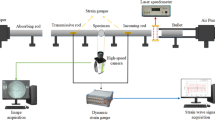Abstract
Within the framework of the search for the method of determination of the strength properties of concrete under the action of an explosion or high-velocity impact, suitable for large scale concrete samples, the evolution of the compression pulse in plates or rods made of concrete with compressive strength of 30 MPa was investigated. It was found that wave configuration consisting of the ramped elastic precursor with insignificant stress jump at the front followed by a dispersed plastic shock wave is formed in the plates under uniaxial shock compression. In this experimental configuration, the compressive strength of the material is not identified. Experiments with concrete rods of various diameters have demonstrated the scalability of the wave process. It was established that the compressive fracture of the rods occurs at a distance of around twice their diameters and is accompanied by the fast decay of the load pulse after that weakly decaying elastic wave was propagated along the rods. The measurements of parameters of the compression pulse at the end of the fracture zone allowed us to determine the value of the dynamic compression strength of concrete equal to \(105\pm 20~\hbox {MPa}\), which turned out to be 3.5 times higher than the static strength.







Similar content being viewed by others
References
Al-Salloum Y, Almusallam T, Ibrahim SM, Abbas H, Alsayed S (2015) Rate dependent behavior and modeling of concrete based on SHPB experiments. Cem Concr Compos 55:34–44. doi:10.1016/j.cemconcomp.2014.07.011
Andrews T, Chapman DJ, Proud WG (2007) The response of concrete to shock-loading. In: AIP conference proceedings, vol 955. pp 470–473
Barker LM, Hollenbach RE (1972) Laser interferometer for measuring high velocities of any reflecting surface. J Appl Phys 43(11):4669–4675. doi:10.1063/1.1660986
Bless S (2002) Using bar impact to determine dynamic properties of ceramics. Ceram Trans 134:225–232
Bless SJ, Tolman J, Levinson S, Nguyen J (2009) Improved bar impact tests using a photonic Doppler velocimeter. In: AIP conference proceedings, vol 1195. pp 615–618. doi:10.1063/1.3295213
Bragov AM, Igumnov LA, Lomunov AK (2015) High-rate deformation of fine-grained concrete and fiber reinforced concrete. In: Publishing house of Nizhny Novgorod University, (Nizhny Novgorod) in Russian
Forquin P (2017) Brittle materials at high-loading rates: an open area of research. Phil Trans R Soc A 375:20160436. doi:10.1098/rsta.2016.0436
Forquin P, Lukic B (2016) Experimental techniques to characterize the mechanical behaviour of ultra-high-strength-concrete under extreme loading conditions. In: Song B, Lamberson L, Casem D, Kimberley J (eds) Dynamic behavior of materials, vol 1. Conference proceedings of the society for experimental mechanics series. Springer, Cham, pp 229–237. doi:10.1007/978-3-319-22452-7_32
Goldstein RV (2014) Scale interaction and ordering effects at fracture. Procedia IUTAM 10:180–192. doi:10.1016/j.piutam.2014.01.017
IAEA (2015) Safety aspects of nuclear power plants in human induced external events: assessment of structures. Safety report no. DD1087
Johnson J, Orbovic N, Ravindra MK, Saarenheimo A, Beltran F, Blahoianu A (2017) Safety aspects of nuclear power plants in human induced external events: general considerations. In: Safety reports series 86. International atomic energy agency (Vienna) ISSN 1020–6450. http://www.iaea.org/books
Kanel GI, Razorenov SV, Fortov VE (2004) Shock-wave phenomena and the properties of condensed matter. Springer, New York. ISBN 0-387-20571-1
Kanel GI, Zaretsky EB, Rajendran A, Razorenov SV, Savinykh AS, Paris V (2009) Search for conditions of compressive fracture of hard brittle ceramics at impact loading. Int J Plast 25(4):649–670. doi:10.1016/j.ijplas.2008.12.004
Lu X, Hsu C-TT (2006) Behavior of high strength concrete with and without steel fiber reinforcement in triaxial compression. Cem Concr Res 36:1679–1685. doi:10.1016/j.cemconres.2006.05.021
Rabczuk T, Eibl J (2006) Modelling dynamic failure of concrete with meshfree methods. Int J Impact Eng 32:1878–1897. doi:10.1016/j.ijimpeng.2005.02.008
Radchenko AV, Radchenko PA (2015) Shock-wave processes and fracture in anisotropic materials and structures. In: Publishing house of Tomsk state architectural-building University (Tomsk) in Russian
Tsembelis K, Proud WG (2005) The dynamic behavior of micro-concrete. In: AIP conference proceedings, vol 845. pp 1496–1499
Zhou XQ, Kuznetsov VA, Hao H, Waschl J (2008) Numerical prediction of concrete slab response to blast loading. Int J Impact Eng 35(10):1186–1200. doi:10.1016/j.ijimpeng.2008.01.004
Acknowledgements
This study was supported by the State Corporation “Rosatom” (state contract no. N.H4kh.241.9B.17.1013, February 20, 2017. The authors are grateful to A. V. Kulikov for the assistance in preparing and conducting experiments.
Author information
Authors and Affiliations
Corresponding author
Rights and permissions
About this article
Cite this article
Savinykh, A.S., Garkushin, G.V., Kanel, G.I. et al. Method of measurement of the dynamic strength of concrete under explosive loading. Int J Fract 209, 109–115 (2018). https://doi.org/10.1007/s10704-017-0244-9
Received:
Accepted:
Published:
Issue Date:
DOI: https://doi.org/10.1007/s10704-017-0244-9




